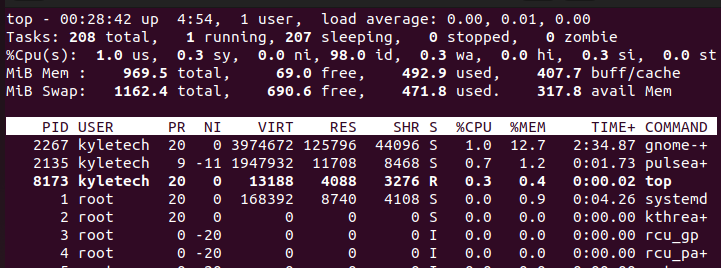We will focus on the most important Linux shell commands that you should know. Check each command and understand how we implement it and apply it on your end when interacting with the shell.
25 Most Important Linux Shell Commands
1. Ls Command
It lists the contents of the current directory.

You can combine it with other options to achieve more functionality. For instance, the “ls –l” option is used for long-listing to see the file properties and permissions.
2. Pwd Command
It shows the current directory that you are in. The output shows the absolute path of the current location:
3. Man Command
The “man” command opens the man page for any command to help you understand how to use it. For instance, here’s how to use the “man” command with the “ls” command:
Press “q” to exit the man page.
4. Mkdir Command
It is used when you want to create a directory. Here’s an example of creating a directory named “linuxhint” in the current location:
You can also specify the path where to create the directory like in the following example:
5. Rmdir Command
The “rmdir” command is used when you want to delete a directory.
6. Touch Command
It is used when you want to create a new file without adding any content. We create a file named “linuxhint.txt” in the following example:
7. Rm Command
It is used when you want to delete the files. Specify the file that you want to delete after the “rm” command. Let’s delete the file that we created with the “touch” command.
If removing a folder, add the “-r” flag to avoid getting an error. Here’s an example:
8. Cd Command
It is used when you want to change your directory to the specified one.
Note the change in the current location on the terminal prompt.
9. Cat Command
It displays the contents of a file.
You can also create a new file and add its contents.
10. Cp Command
It is used to copy the files and directories from one location to another. The copied file or folder remains in its current location.
11. Mv Command
Use the “mv” command if you want to move a file or directory. You can also use it to rename a file or folder.
12. Grep Command
The command is used when you want to search through a text or a standard output. For instance, we list the contents of the current directory in the following example to filter all text files:
13. Sudo Command
It is an ideal command to execute the commands with superuser or root privileges. When running administrative commands such as updates or installations, you must add the sudo statement before the command.
14. Clear Command
After typing numerous commands in your terminal, use the “clear” command to clear the terminal screen and leave it clean for you to type new commands.
15. Whoami
It prints the currently logged-in user.
16. Uname
It gives details about the system; you can use it with different options.
To get all the information about your device’s architecture, add the “-a” option.
17. Head Command
It is used to work with files. When you add the head command, it opens a file and prints the first ten lines in the text.
18. Tail Command
It is used to open a file and print its last ten lines. You can also specify the number of lines that you wish to open.
19. Df Command
This command is used when you want to check the statistics of the disk space on your system.
20. Du Command
Using the disk usage command, you can check the space of a file or directory that takes up in your system.
21. Diff Command
The “diff” command is used to compare the different files to print their difference. Specify the names of the files that you want to compare.
22. Find Command
This command finds the target file or directory throughout the system. Specify the file name or directory that you want to find, and you will get its path.
23. Locate Command
You must install “locate” on your system before you can use the command to search for files on your system. It checks the database to search for specified filename quickly.
24. Top Command
It shows all the running processes and their process ID in real-time.
25. Uptime Command
It shows how long the system has been up, the number of active users, and the load average.
Conclusion
There are numerous Linux shell commands that you can utilize for different tasks. We covered the most commonly used commands that you can try and use when working with shell on your system. Try them out!




























